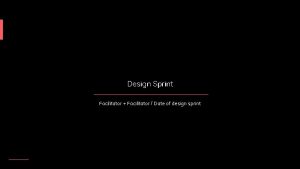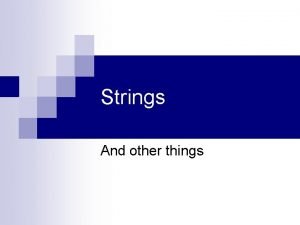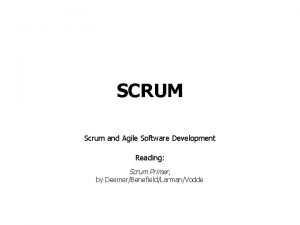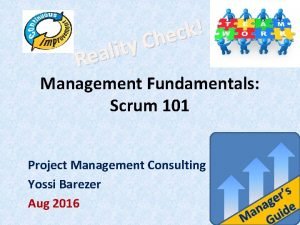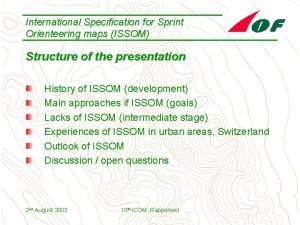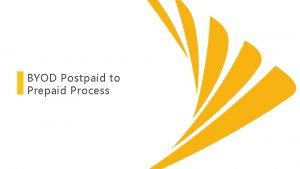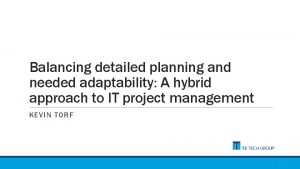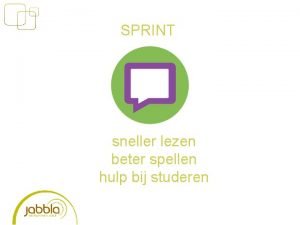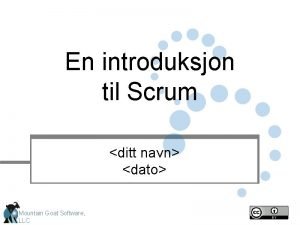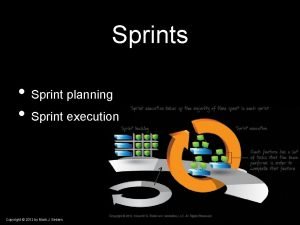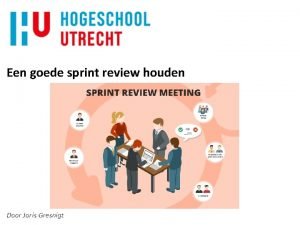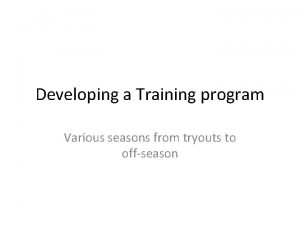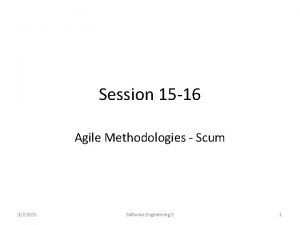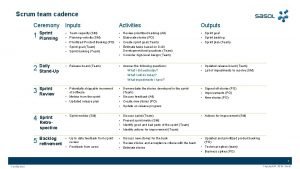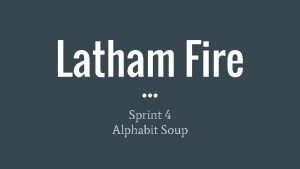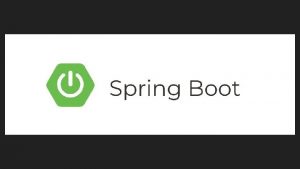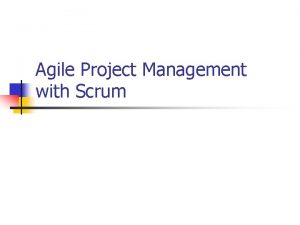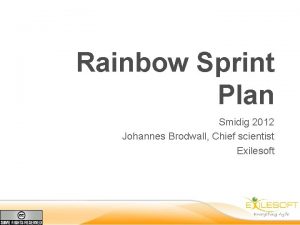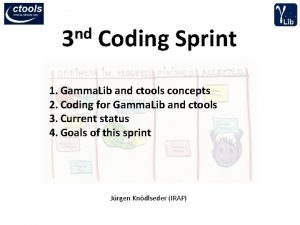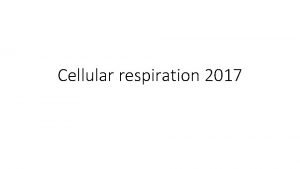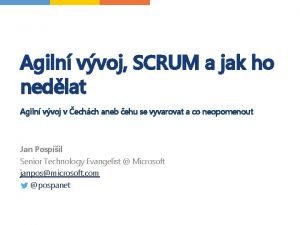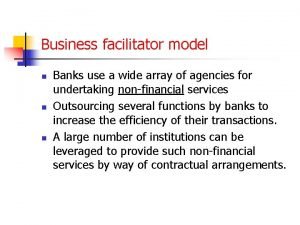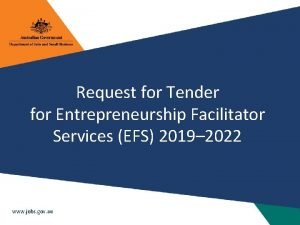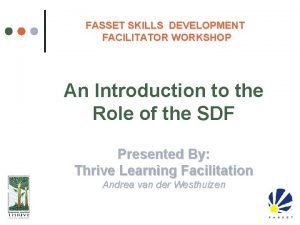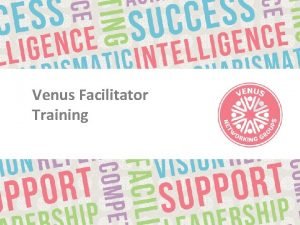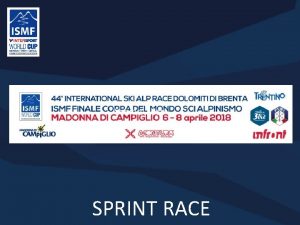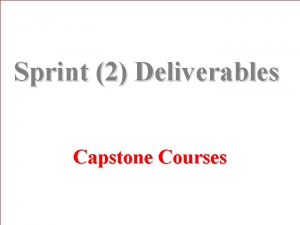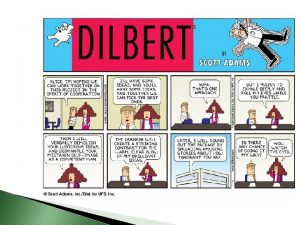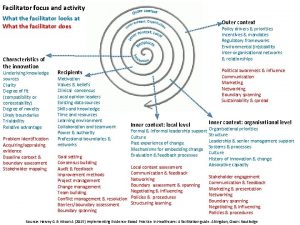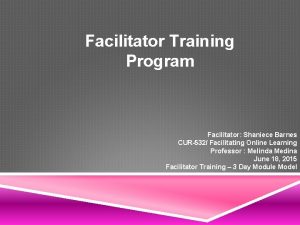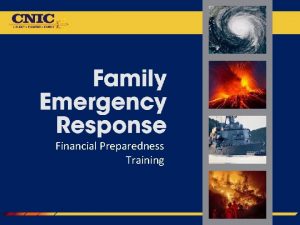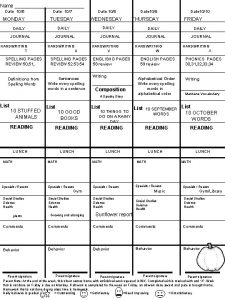Design Sprint Facilitator Facilitator Date of design sprint






















































- Slides: 54

Design Sprint Facilitator + Facilitator / Date of design sprint

Who should you invite? 1. Get a Good Mix 3. Brainstorming is Not For Everyone Try to get at least one rep from each department. The more brains from different areas, the better the output. Make sure you manage expectations upfront. Some people might find such loose ideation stressful or frustrating. 2. Limit to 8 People 4. Schedule the Time Over time this has become the sweet spot for the number of ideas generated versus the amount of different brains in the room. Make sure you have at least one day of everyone’s time if it’s small in scope. Ideally, keep it to two days for medium to large problem areas. 2

Facilitators Facilitator Name (Title) 3

Questions? Sharing! #slack-channel-name You can ask questions via Slack. 4

SCHEDULE 5

Schedule - Day One 1 Day One / 9: 00 -9: 30 : Introduction 2 Day One / 9: 30 -10: 30 : Presentation 3 Day One / 10: 30 -10: 45 : Coffee Break 4 Day One / 10: 45 -11: 15: Research on Ideas 5 Day One / 11: 15 -12: 00: Show & Tell 6

Schedule - Day Two 1 Day Two / 9: 00 -9: 15 : Recap 2 Day Two / 9: 15 -9: 30 : Crazy 8’s 3 Day Two / 9: 30 -10: 00 : Polish Ideas 4 Day Two / 10: 00 -10: 45 : Present Two Concepts & Discuss 5 Day Two / 10: 45 -11: 00 : Coffee Break 6 Day Two / 11: 00 -11: 45 : Present Two Concepts & Discuss 7 Day Two / 11: 45 -12: 00 : Wrap Up/ROTI/Feedback 7

OBJECTIVE 8

START WITH THE QUESTION OF HOW MIGHT WE _______ AND KEEP YOUR OBJECTIVE FOCUSED. For example: 1. How might we define a better onboarding experience? 2. How might we promote trust inside our product when utilizing machine learning? 3. How might we automate and simplify creation for our customers? 9

THE MODIFIED UNBOUNCE DESIGN SPRINT Not a Google design sprint. The goal is to get ideas to develop concepts that we can test with users, and start exploring. 10

Decide Diverge Choose the best idea and storyboard the idea. Research, envision, develop lots of solutions and ideate. Design Sprint Understand Prototype Who are the users, what are their needs, what is the context, competitor review and formulate a strategy. Build something quick and dirty to show to users. Focus on making it beautiful. Validate Show prototype to real users outside the organisation. Learn what doesn’t work. 11

Additional Context At this point you can contextualize the problem with prior research, concept testing, experience principles, archetypes, target segments, possibilities of ML/AI etc. . . 12

RULES OF ENGAGEMENT 13

Rules of Engagement 1. Defer Judgement 3. Build on the Ideas of Others Creative spaces don’t judge. They let ideas flow and foster great ideas. Being positive and building on the ideas of others take some skill. In conversation, we try to use and instead of but. . . 2. Encourage Wild Ideas 4. Stay Focused on the Topic Wild ideas can often give rise to creative leaps. Don’t be afraid of wacky and out there. Keep the conversation on target. Otherwise you can diverge beyond scope or what we’re trying to design for. 14

Rules of Engagement cont’d. . . 5. One Conversation at a Time 7. Go For Quantity Always think about the challenge topic and give your input by joining a conversation not starting a new one. Aim for as many ideas as possible. In a good session, up to 100 ideas are generated in 60 minutes. Crank the ideas out quickly. 6. Be Visual 8. Stay Analog Nothing gets an idea across faster than drawing it. It’s all about the idea behind your sketch, not the drawing quality. As much as possible, please leave your phones in your pockets and laptops closed (if you can!) 15

OUTPUT & NEXT STEPS 16

Outline what you hope to accomplish by running this sprint. Below are examples. 1. Utilize ML & AI Find new ways in which ML and AI would be useful in our industry. 2. Future Proofing Create concepts for the purpose of usability testing in future prototypes. 3. Onboarding Reduce the amount of time it takes our customers to create for the first time. 17

45 MIN UNPACKING THE PROBLEM Set the context, goal of sprint, the problem spaces that surfaced out of our research and concept tests, etc. 18

Unpack Your Primary Goal Describe what will make the ideal experience successful and what obstacles users face. Contextualize the pain points. For example: Onboarding. 19

What does it mean for your team/company? Explain how the primary goal increases the value of your product to your customers, and how that value translates into business metrics that matter to you (examples below): 1. ONBOARDING (MRR) 2. ADOPTION (GROWTH) 3. STICKINESS (CHURN) 20

15 MIN COFFEE BREAK 21

POLISH YOUR IDEAS 22

45 MIN RESEARCH Everyone take time to research individually. Take your own notes. What is out there on advertising, website and design platforms etc. . . How may we. . . ”REPEAT YOUR OBJECTIVE HERE” 23

Repeat The Goals & Value Communicate your goals of the sprint again and recap the value and what it means to your company/team. 1. POINT ONE 2. POINT TWO 3. POINT THREE 4. POINT FOUR 24

PRESENT CONCEPTS & DISCUSS 25

45 MIN SHOW & TELL OF YOUR RESEARCH Please share your findings with the rest of the group. Best onboarding practices, great brand guidelines, advances in technology etc. . . ”REPEAT YOUR OBJECTIVE HERE” 26

DAY 2: WELCOME BACK 27

Schedule - Day Two 1 Day Two / 9: 00 -9: 15 : Recap 2 Day Two / 9: 15 -9: 30 : Crazy 8’s 3 Day Two / 9: 30 -10: 00 : Polish Ideas 4 Day Two / 10: 00 -10: 45 : Present Two Concepts & Discuss 5 Day Two / 10: 45 -11: 00 : Coffee Break 6 Day Two / 11: 00 -11: 15 : Present Two Concepts & Discuss 7 Day Two / 11: 15 -12: 00 : Discussion and Wrap Up 28

RULES OF ENGAGEMENT 29

Rules of Engagement 1. Defer Judgement 3. Build on the Ideas of Others Creative spaces don’t judge. They let ideas flow and foster great ideas. Being positive and building on the ideas of others take some skill. In conversation, we try to use and instead of but. . . 2. Encourage Wild Ideas 4. Stay Focused on the Topic Wild ideas can often give rise to creative leaps. Don’t be afraid of wacky and out there. Keep the conversation on target. Otherwise you can diverge beyond scope or what we’re trying to design for. 30

Rules of Engagement 5. One Conversation at a Time 7. Go For Quantity Always think about the challenge topic and give your input by joining a conversation not starting a new one. Aim for as many ideas as possible. In a good session, up to 100 ideas are generated in 60 minutes. Crank the ideas out quickly. 6. Be Visual 8. Stay Analog Nothing gets an idea across faster than drawing it. It’s all about the idea behind your sketch, not the drawing quality. As much as possible, please leave your phones in your pockets and laptops closed (if you can!) 31

15 MIN CRAZY 8’S SKETCHING Fold a blank sheet of paper in half four times. Unfold it. You have 5 minutes total to draw eight sketches, one in each panel. 32

Crazy 8’s Example One 33

Crazy 8’s Example Two 34

Repeat The Goals & Value Communicate your goals of the sprint again and recap the value and what it means to your company/team. 1. POINT ONE 2. POINT TWO 3. POINT THREE 4. POINT FOUR 35

OBJECTIVE 36

START WITH THE QUESTION OF HOW MIGHT WE _______ AND KEEP YOUR OBJECTIVE FOCUSED. For example: 1. How might we define a better onboarding experience? 2. How might we promote trust inside our product when utilizing machine learning? 3. How might we automate and simplify creation for our customers? 37

30 MIN TAKE SOME TIME TO GO OVER YOUR CRAZY 8 SKETCHES. COME UP WITH YOUR FINAL 2 CONCEPTS AND SKETCHES THAT YOU’D LIKE TO SHARE WITH THE REST OF THE GROUP. Please keep our objective in mind. 38

Example Concept The algorithm will detect trends and notify you of new insights. 39

Example Concept Alerts that notify you of significant changes in conversation rates or traffic. This would include both increases and decreases. 40

45 MIN YOU HAVE 10 MIN TO PRESENT & DISCUSS. Present your final two concepts to the group. Share how you kept the objective in mind and how you connected the dots with the objectives. 41

Rules of Engagement 1. Defer Judgement 3. Build on the Ideas of Others Creative spaces don’t judge. They let ideas flow and foster great ideas. Being positive and building on the ideas of others take some skill. In conversation, we try to use and instead of but. . . 2. Encourage Wild Ideas 4. Stay Focused on the Topic Wild ideas can often give rise to creative leaps. Don’t be afraid of wacky and out there. Keep the conversation on target. Otherwise you can diverge beyond scope or what we’re trying to design for. 42

Rules of Engagement 5. One Conversation at a Time 7. Go For Quantity Always think about the challenge topic and give your input by joining a conversation not starting a new one. Aim for as many ideas as possible. In a good session, up to 100 ideas are generated in 60 minutes. Crank the ideas out quickly. 6. Be Visual 8. Stay Analog Nothing gets an idea across faster than drawing it. It’s all about the idea behind your sketch, not the drawing quality. As much as possible, please leave your phones in your pockets and laptops closed (if you can!) 43

COFFEE BREAK 44

45 MIN CONTINUED YOU HAVE 10 MIN TO PRESENT & DISCUSS. Present your final two concepts to the group. Share how you kept the objective in mind and how you connected the dots with the objectives. 45

Rules of Engagement 1. Defer Judgement 3. Build on the Ideas of Others Creative spaces don’t judge. They let ideas flow and foster great ideas. Being positive and building on the ideas of others take some skill. In conversation, we try to use and instead of but. . . 2. Encourage Wild Ideas 4. Stay Focused on the Topic Wild ideas can often give rise to creative leaps. Don’t be afraid of wacky and out there. Keep the conversation on target. Otherwise you can diverge beyond scope or what we’re trying to design for. 46

Rules of Engagement 5. One Conversation at a Time 7. Go For Quantity Always think about the challenge topic and give your input by joining a conversation not starting a new one. Aim for as many ideas as possible. In a good session, up to 100 ideas are generated in 60 minutes. Crank the ideas out quickly. 6. Be Visual 8. Stay Analog Nothing gets an idea across faster than drawing it. It’s all about the idea behind your sketch, not the drawing quality. As much as possible, please leave your phones in your pockets and laptops closed (if you can!) 47

OBJECTIVE 48

START WITH THE QUESTION OF HOW MIGHT WE _______ AND KEEP YOUR OBJECTIVE FOCUSED. For example: 1. How might we define a better onboarding experience? 2. How might we promote trust inside our product when utilizing machine learning? 3. How might we automate and simplify creation for our customers? 49

Design Sprint Next Steps / Roti

Questions? Sharing! #slack-channel-name You can ask questions via Slack. 51

THANK YOU EVERYONE! Facilitator Name (Title) 52

ANALYSIS & VOTING 53

The MIRO Board 1. Document all the ideas 3. How to vote Collect all of the crazy 8’s into Miro / Realtime Board. Add descriptions under the crazy 8 s so you can refer back to each one later. Engineering votes on greatest feasibility, UX votes on what’s best for the user, PM votes on what’s best for the business, PMM votes on what’s most marketable. 2. Get everyone to vote 4. Concept Testing Candidates After the sprint reach to each person in your session: PM, PMM, CS, Engineering, etc. , to vote by their relative expertise. Scale is from 1 to 3 (1 = not valuable, 3 = very valuable) The final output has a total score and the top 10 are ideally concept testing. 54
 Sprint facilitator
Sprint facilitator Types of dividend policy
Types of dividend policy Homemade dividend
Homemade dividend Design sprint playbook
Design sprint playbook String and other things
String and other things Product backlog example
Product backlog example Ead sprint com citrix
Ead sprint com citrix Sprint review timebox
Sprint review timebox Ioos trento
Ioos trento Issom
Issom Sprint byod
Sprint byod Battle card definition
Battle card definition Sprint timelines
Sprint timelines Sprintviewer
Sprintviewer Te solar sprint ii
Te solar sprint ii Sprint backlog belongs solely to the
Sprint backlog belongs solely to the Metaphor for proud
Metaphor for proud Sprintmål
Sprintmål Sprint execution
Sprint execution Bases de datos mas grandes
Bases de datos mas grandes Sprint reveiw
Sprint reveiw 30m sprint fatigue test
30m sprint fatigue test Agile and scum
Agile and scum Contoh product backlog
Contoh product backlog Sprint planning outputs
Sprint planning outputs Fire bar sprint
Fire bar sprint Start.spring io
Start.spring io At the seventh sprint review the stakeholders
At the seventh sprint review the stakeholders Rast test sprint
Rast test sprint Face pulls exrx
Face pulls exrx Sprint dividend yield
Sprint dividend yield Vasp convergence
Vasp convergence Ellen tuenter
Ellen tuenter Rainbow sprint
Rainbow sprint Vertical definition
Vertical definition Why do runners breathe heavily after a sprint race
Why do runners breathe heavily after a sprint race Sprint senior plan
Sprint senior plan Plc facilitator
Plc facilitator Virginia math pathways
Virginia math pathways Unjustified restrictive gatekeeping
Unjustified restrictive gatekeeping Authority style of teaching
Authority style of teaching Facilitator course distance learning
Facilitator course distance learning Focus group facilitator
Focus group facilitator Facilitátor feladatai
Facilitátor feladatai Cover letter workshop activities
Cover letter workshop activities Business facilitator in banks
Business facilitator in banks Thank you message for facilitator
Thank you message for facilitator Thank you message to training facilitator
Thank you message to training facilitator Entrepreneurship facilitator
Entrepreneurship facilitator Skills development facilitator
Skills development facilitator Family law facilitator
Family law facilitator Qualities of a facilitator
Qualities of a facilitator Thank you facilitator
Thank you facilitator How to thank a facilitator
How to thank a facilitator How to thank a training facilitator
How to thank a training facilitator
